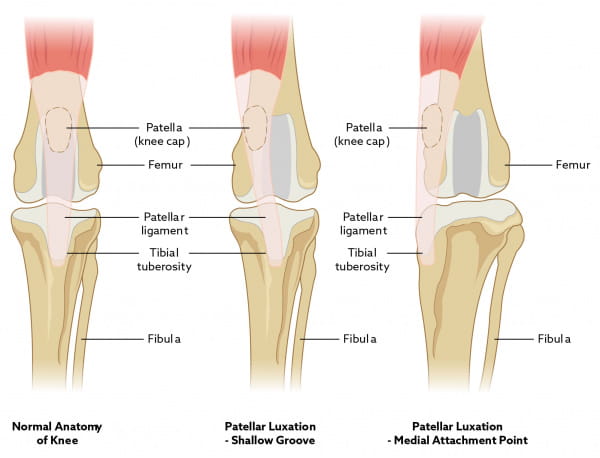Luxating Patella Surgery Risks Happing Again
What is a luxating patella? 
The patella, or 'kneecap,' is normally located in a groove on the end of the femur (thigh bone) but to a higher place the stifle (knee).
"The term luxating means out of place."
The term luxating means 'out of place' or 'dislocated'. Therefore, a luxating patella is a kneecap that moves out of its normal location. Pet owners may notice a skip in their domestic dog'south step or meet their dog run on three legs. Then of a sudden they will be back on all four legs as if naught happened.
What causes a patellar luxation? 
The kneecap sits underneath a ligament called the patellar ligament. This ligament attaches the large thigh muscles to a point on the center front of the shin bone (tibia). When the thigh muscles contract, the strength is transmitted through the patellar ligament, pulling on the shin bone. This results in extension or straightening of the knee. The patella slides upward and downwardly in its groove (trochlear groove) and helps keep the patellar ligament in place during this movement.
"Many toy or small breed dogs have a genetic predisposition for a luxating patella."
Many toy or small breed dogs, including Maltese, Chihuahua, French Poodle, and Bichon Frise dogs, have a genetic predisposition for a luxating patella. In some dogs, (peculiarly ones that are bowlegged), the patella may luxate because the point of attachment of the patellar ligament is not on the eye of the shin bone. In these cases, it is almost always located as well far toward the middle of the torso or the inside of the leg. As the thigh muscles contract, the force applied to the patella pulls it to the inside of the articulatio genus. After several months or years of this abnormal movement, the inner side of the groove in the femur may wear down. One time this happens, the patella is and so free to dislocate or slide toward the inside of the knee.
When the patella luxates, the dog has difficulty bearing weight on the leg, although in that location are rarely whatever signs of pain. It may larn how to kicking the leg to the side, which volition hyperextend the articulatio genus and snap the patella back into its normal location. Medically, there are several degrees or grades of patellar luxation, ranging from a balmy form in which the kneecap but luxates when force is practical direct to it, to moderate luxation in which the kneecap pops out frequently, all the mode to a severe luxation, in which the kneecap may exist confused the majority of the time. In affected dogs, i or both kneecaps may luxate, sometimes to a different degree. Approximately 50% of afflicted dogs have both knees involved while the other 50% have only one knee involved.
Does a luxating patella cause any long-term problems for my dog?
This depends upon the grade of the luxation and whether both legs are afflicted to the same degree. Patellar luxations are graded from Grade I-Four. Some dogs can tolerate this status for many years, even for their entire life.
"Patellar luxation predisposes the knee joint to other injuries such every bit torn cruciate ligaments."
However, patellar luxation predisposes the genu to other injuries, such as torn cruciate ligaments (meet handout "Cruciate Ligament Rupture in Dogs"). The weight bearing stress on the leg is also altered, leading to changes in the hips, thigh, and shin bones. As the pet ages, arthritis develops and results in non only decreased mobility but joint pain besides.
Tin a luxating patella exist corrected?
Surgery should exist performed if your dog has recurrent or persistent lameness or if other knee joint injuries occur secondary to the luxating patella. Grade I patellar luxations are not commonly surgically repaired, simply Grades II-Four are. Surgical repair generally involves three steps:
1) The point of zipper of the patellar ligament to the shin bone is transplanted (moved) to its proper location.
two) The groove in the femur is deepened and so the patella will stay in place.
3) The sheathing around the joint is tightened. When the patella luxates, the joint capsule stretches. Tightening it helps to prevent the patella from luxating again.
An implant may also placed on the inside of the articulatio genus, making the patella unable to slip over it.
Post-operatively, the recovery period is normally very rapid, especially with appropriate pain management.
What is the prognosis?
If your veterinarian performs surgery earlier arthritis or other knee injury occurs, the prognosis is excellent. Your dog should regain full use of its leg. However, if arthritis has already developed in the knee joint, your dog may feel intermittent pain in the leg and the arthritis may progress. The higher the form, of luxating patella, the higher the likelihood of reoccurrence postoperatively. Prescription anti-inflammatories, articulation supplements, and/or special therapeutic joint diets may slow the progression of arthritis and help command any discomfort. Weight reduction is also recommended for pets that are overweight.
Consult with your veterinarian to make up one's mind the best post-operative plan for your pet.
Source: https://vcahospitals.com/know-your-pet/luxating-patella-in-dogs
Post a Comment for "Luxating Patella Surgery Risks Happing Again"